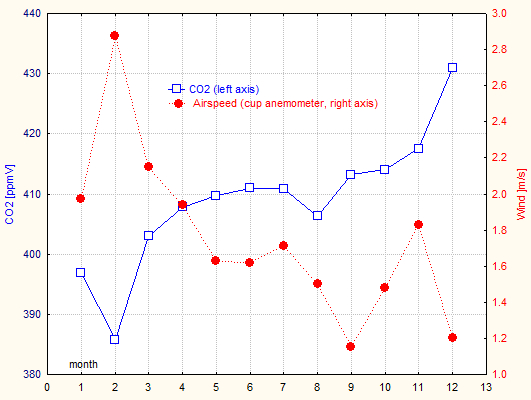("bad ozone")
Mean and stdev of the year 2016: 39.9 +/- 31.2
Mean
+/- stdev:
1998 to 2016:
39.5 +/- 6.6 ug/m3
2002 to 2016: 38.5 +/- 7.2
Trends 1998 - 2015: -0.24 per year
2002 -
2015: +0.03 per year (flat trend!)
Watch the left scale to note that trends are very small!

("good ozone")
Mean and stdev of the year 2016: 317.9 +/- 45.4
minimum : 219.0 (12 Nov)
maximum: 422.0 (24 Apr)
Uccle (Brewer 16&178, DS only): 331.1 +/- 41.4
Trendlines (start year is x =
1):
1998 to 2016: 314.0 + 0.1*x (+1
DU/decade)
2002 to 2016:
332.2 - 0.5*x (- 5 DU/decade )
(Uccle
gives +0.95DU*y-1 for the 1998-2010 period)
(see also [16])
Calibration
multiplier to apply to the Diekirch DU data [55]:
if Uccle Brewer 16 is the reference: 0.96-1 = 1.04 (R2 =0.802)
if Uccle Brewers 16&178 are the
reference: 0.97-1 =
1.03 (R2=0.795)
See [4] [8]
([8] shows strong
positive trend starting 1990 for
latitudes 45°-75° North, Europe): [27] give +1.32
DU/y at the Jungfraujoch for 1995-2004.
See also recent EGU2009 poster [16].
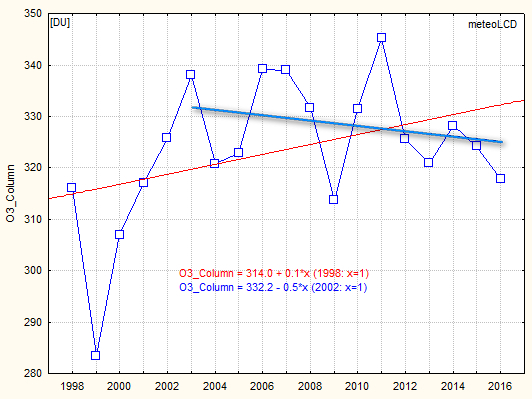
Mean and stdev of the year 2015: 407.6 +/- 4.9
The 1998-2001 data are too unreliable to be retained
for the trend analysis.
Trendlines :
2002 to 2012: 400.31 + 1.36*x
(2002: x=1)
2013 to 2016:
400.75 + 2.00*x (2013: x=1)
The sharp plunge in 2013 should be taken with caution;
there also was a change in the calibration gas the 21 Jan. 2014.
The second picture zooms on the last 4 years, and
gives the readings of Diekirch, Mauna Loa (MLO) and Hohenpeissenberg (HPB,
only from 2013 to 2015, 2016 data not yet available). Note the very
different elevations! Mauna Loa has no vegetation at all, Diekirch and HPB
similar grass and forests.
The yearly trends are:
| Diekirch | + 2.00 ppmV/year | |
| Hohenpeissenberg | + 1.48 ppmV/year | [48] |
| Manua Loa | + 2.53 ppmV/year | [34] |
The CO2 data (monthly averages) often show the summer-time lows and
winter highs, which reflect the impact of variable seasonal photo-synthesis (see here).
A simple 12
month periodic sinus pattern was found in 2014 and 2015.
Actually, as shown in addendum 3, the CO2 lowering intensity of wind
speed seems to be an important modifier of this pattern, possibly masking the effect (or
better: the non-effect) of photosynthesis. This happened in 2016, as the
seasonal swing is much less sinusoidal, and only a sharp minimum in August
can be seen.
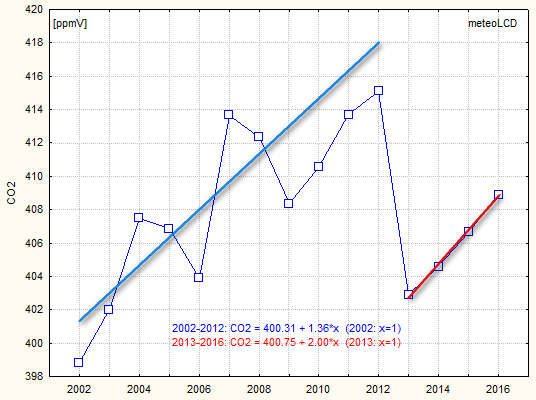 .
.
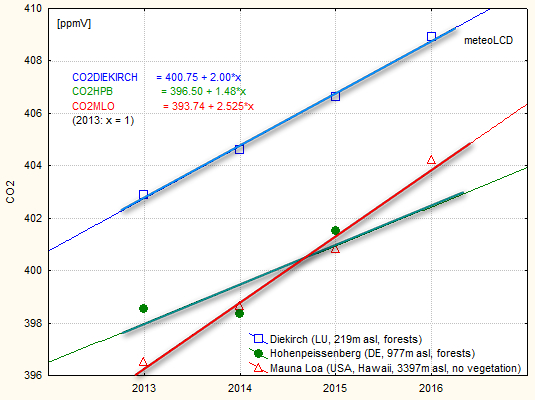
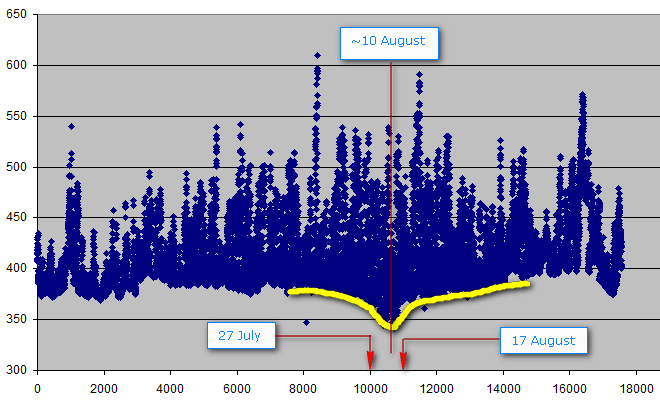
Mean and stdev of the year 2016
(from monthly averages):
Diekirch: 11.15 +/- 6.81 (11.16 from all half-hour readings)
Findel: 10.83 +/- 6.90
Mean temperatures (+/- stdev):
1998 to 2016 :
10.37 +/- 0.48 °C
2002 to 2016 : 10.43 +/- 0.51 °C
2007 to 2016 : 10.44 +/- 0.66 °C (last decade)
The
sensor location has not been moved since 2002! The old thermistor sensor has
been replaced by a PT100
(see comments in 2015_only.xls); new 4-20mA
amplifier (with calibration) installed the 4th May 2016.
Trends from 2002 to 2016 (2016 was a very strong El Nino year!):
meteoLCD: +0.017 °C/year
Findel: +0.032
°C/year
Latest Global temperature anomaly trends for same period:
UAH (satellite) : + 0.009°C/year [45]
RSS (satellite) : + 0.005°C/year
CRU (Hadcrut4): + 0.009°C/year
Highest decadal Central England warming trend from 1691 to 2009:
+1.86°C/decade for 1694-1703!
See also [15] (which may be obsolete)
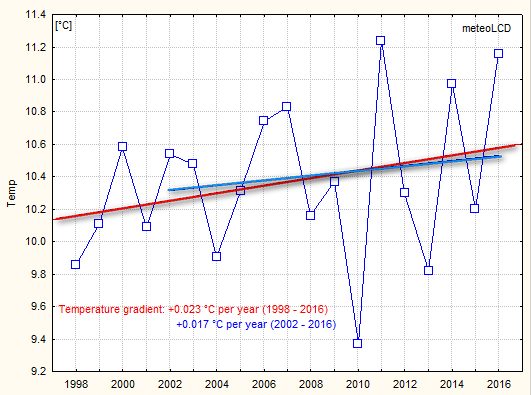
Range (DTR) [°C]
DTR = daily max - daily min temperature
Mean and stdev of the year 2016 (from monthly
averages):
Diekirch: 8.31 +/- 2.55 (8.79 from all half-hour readings)
Findel: 7.58 +/- 2.22
Mean DTR (
+/- stdev):
1998 to 2016: 8.52 +/-
0.54
2002 to 2016: 8.63 +/- 0.55
2007 to 2016: 8.58 +/- 0.47 (last decade; trend is slightly positive:
+0.003 °C/y)
For 2002 to 2016: all trends are practically flat (DTR
would diminish by 0.17°C/century, which is insignificant)
Findel DTR trend is flat from 2004 to 2015 (+0.001 °C/year)
A fingerprint of climate warming is that daily minima increase more
rapidly than
daily maxima so that the DTR trend should become negative. Clearly the
data for the last decade do not show this neither at Diekirch nor at the Findel.
The BEST data set for Luxembourg [29] stops at
2013.
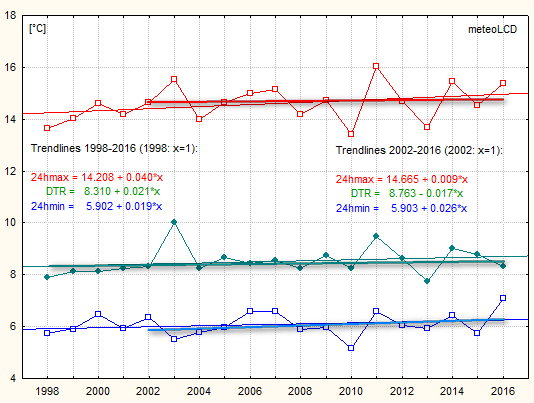 .
.Values of DJF temperature of the year 2016:
Diekirch: 3.66
Findel: 4.13
Contrary to what is often suggested in the media, winters were cooling since 2002 to 2013. The cooling trend (about -0.5 °C/decade) has now reversed into a slight warming.
Trends from 2002 to 2016 (2016 was a very strong El Nino year!):
Diekirch: +0.068 °C/year since
2002
Findel: +0.074
Germany: +0.093 [46]
NAO: +0.028 NAO normalized index/year
The plot shows the mean temperatures of
December (from previous year), January and February. It also shows in
brown the NAO index for the months Dec to Feb [47]
The North Atlantic Oscillation clearly influences
our winters (but note the exception for the strong 2016 El Nino year!
[51]); the correlations between the Diekirch DJF
temperature series
Findel, DE and NAO normalized index are 0.94, 0.93 and 0.50, all except the
last (NAO) significant at the 5% level. The NAO
index for 2016
does not include the December data, so the 0.5
correlation values might slightly change.
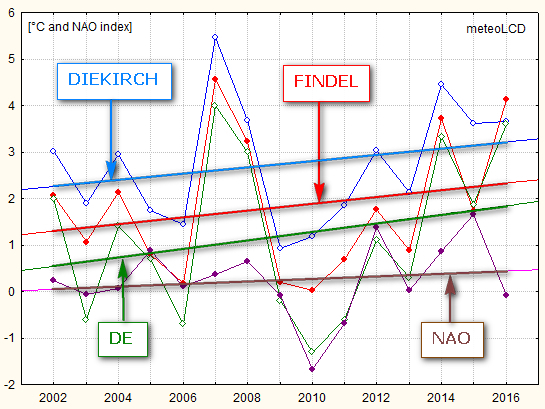
Mean moist enthalpy of 2016: 30.72 +/- 14.41 kJ/kg
See [24] on how the energy content of moist air is
calculated. Several authors, (e.g. Prof. Roger Pielke Sr.) insist that air
temperature is a poor metric for global warming/cooling, and that the energy
content of the moist air and/or the Ocean Heat Content (OHC) are better
metrics.
Mean yearly moist enthalpy values are very close, but they may change from
zero up to 60 KJ/kg during a year. Moist enthalpy can not be
calculated for temperatures <= 0 °C.
mean +/- stdev:
2002 to 2016
27.98 +/- 1.20 kJ/kg
Trend is slightly negative from 2002 to 2016 (which would point to an
ongoing cooling trend), but note the spectacular rise for the strong El Nino
year 2016.
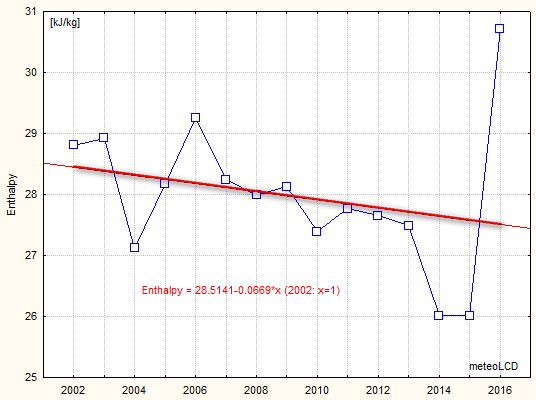
Values of rainfall (precipitation) of the year 2016:
Diekirch: 602.4
Findel: 864.6
1998 to 2016 mean +/- stdev: 695.5 +/- 136.5 mm
2002 to 2016 mean +/-stdev: 651.6 +/_105.8 mm
The negative trend from 1998 to 2015 seems spectacular:
-120 mm/decade, which comes from the very high values of 2000 and 2001.
The 2002-2016 period has a much lower trend
of -36.4 mm/decade.
Clearly precipitation shows an oscillation pattern, so linear trends should be taken with precaution. A good model for the Diekirch data is a sinus function of 5.35 years period (~64 months, R2 = 0.62; see lower graph). If we take the period 2005 - 2016 corresponding to 2 full periods, the linear trend becomes positive with +5.2 mm/y !
The same model suggests a similar period of 5.73
years for the Findel precipitation pattern (R2 = 0.52)
[6] gives short term periods of 6 to 7 years for
the Western European region.
The third plot shows both the Findel and Diekirch annual precipitation, with the averages as dotted lines. Clearly the Findel readings are always higher, which seems normal considering the exposed situation at Findel airport versus Diekirch situated at the bottom of a valley (the elevation at Findel is also higher by 156 m ).
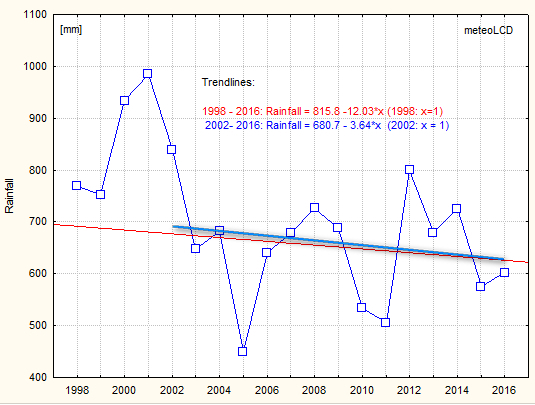
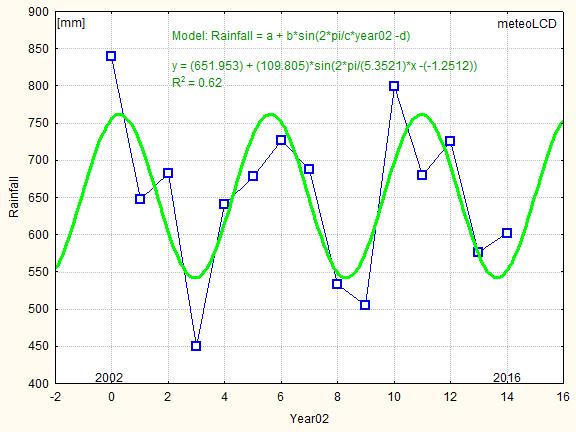
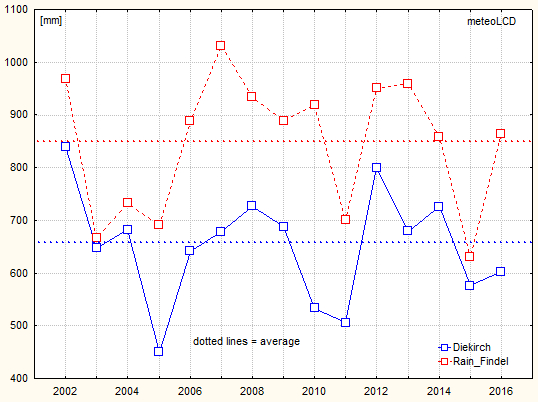
Values of total solar energy
of the year 2016:
Diekirch: 1052.1 KWh/m2
Uccle: 1111.7 [49]
1998 to 2016 mean +/- stdev: 1107.1 +/- 44.9 kWh/m2
2002 to 2016 mean +/- stdev: 1104.8 +/- 48.8 kWh/m2
Visible negative trend:
1998 to 2016: -24.6 kWhm-2/decade
(not surprising with exceptional 2003 peak!)
Large drop in 2016 causes clear negative trend of -18 kWh/m-2 per decade for
the period 2004 to 2016
(the very weak actual solar cycle #24 started in Jan. 2009, reached its last
peak at the start of 2014 and was close to the minimum at the end of 2016).
[52]
(see
Addendum 1 for calculations of radiative
forcing and solar sensitivity, addendum 2 for
detecting a solar influence on temperature and moist enthalpy)
Helioclim satellite measurements show ongoing solar dimming over
Luxembourg for 1985 to 2005 [33] (see
graph)
[14] finds 0.7 Wm-2y-1
for West-Europe 1994-2003 , meteoLCD +1 Wm-2y-1 for
1998-2003.See also [9]
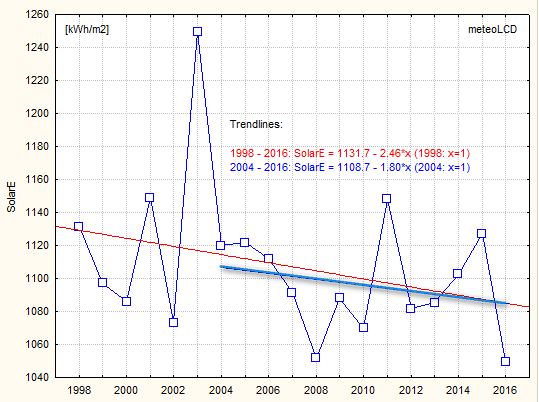
(meteoLCD values derived from pyranometer data by Olivieri's method)
Values of sunshine hours
of the year 2016:
Diekirch: 1524 hours (215m asl)
Findel: 1657 hours
(365m asl, Campbell- Stokes)
Trier:
1448 hours (279m asl)
[40]
[53]
Maastricht: 1715 hours (114m asl)
[53]
Negative trends:
1998 to 2016: - 50 hours/decade
2004 to 2016: - 126 hours/decade
The decline from 2012 to 2013 is -10.8%, to be compared to the data from the Fraunhofer Institut which gives a decline of -10.6 % of the German PV "Volllasttunden" [37]. For a graph on the evolution of the German PV capacity factors click here.
See paper
[23] by F. Massen
comparing 4 different methods to compute sunshine duration from pyranometer
This graph shows the plots of the four above-mentioned stations. It should be noted that meteoLCD (Diekirch) is located in a valley, Findel, Trier and Maastricht airport on top of a plateau. The Findel totals are much higher than those of the other stations, which certainly is also partially caused by the use of the Campbell-Stokes instrument known to give too high readings (in July and August the excess of Findel readings was highest).
All 4 stations give totals that practically always vary in the same manner (synchronous increase and decrease).
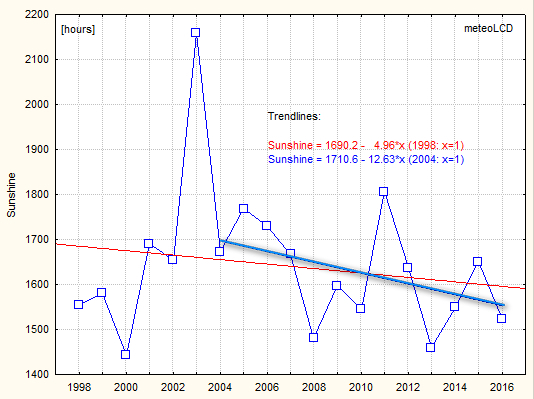
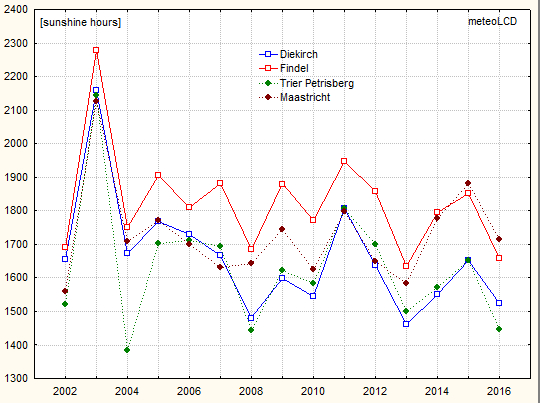
Erythemal UVB dose of the year 2016: 0.132 KWh/m2
mean +/- stdev:
1998 to 2016: 0.130 +/- 0.008 eff. kWh*m-2y-1
2004 to 2016: 0.130 +/- 0.005
Trends over 1998-2016 and 2004-2016 are the same, are practically flat!
From 2002 to 2016, the trend is slightly negative (-0.0002 eff. kWh*m-2y-1); this is compatible with the small decrease in TOC (total ozone column). Several comments [54] have shown that the RAF (radiation amplification factor) at Diekirch is about 1.0. If we apply the RAF formula to the start and end-points of the 2002-2016 trendlines of UVBdose and TOC we get 1.006 = ~1
See
[10]
and [22] (poster finds slight
positive trend in June (+2%) and negative trend in August (-1%), no trend
for other months, for period 1991 to 2008)
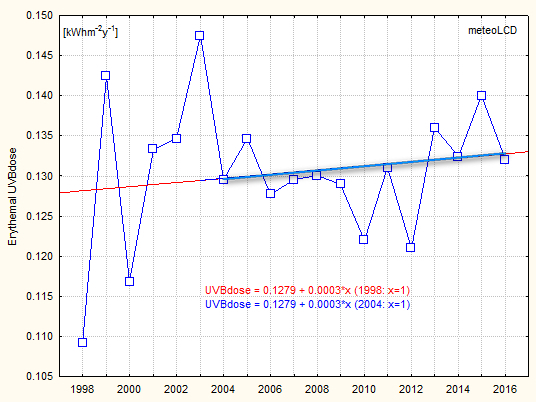
UVA dose of the year 2016: 52.7 KWh/m2
(some problems with internal temperature stabilization of the sensor)
mean +/- stdev:
1998 to 2016 54.0 +/- 4.6 kWh*m-2*y-1
2004 to 2016: 54.2 +/- 3.9
Overall trend is nearly flat, from 2004 to 2016 slightly negative.
The 2 independent measures of solar energy and UVA doses all point to a slight solar dimming since 2004.
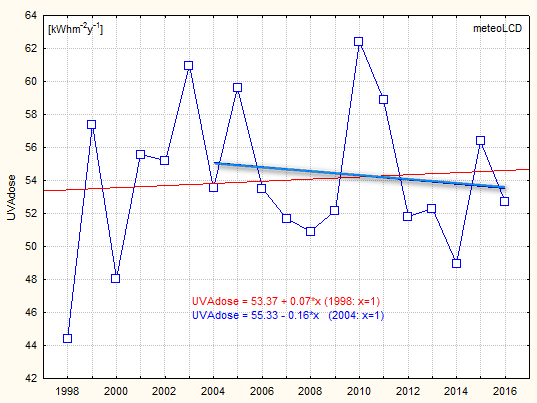
(End of measurements useable for trends in 2013. No trends will be calculated for this year!)
Attention: only
70% of possible measurements available due to sensor downtime!
Comparison between yearly averages at Diekirch, Luxembourg-Bonnevoie and
Vianden (rural)
[39]; Luxembourg and Vianden values derived by
inspection from graphs):
|
ug/m3 |
NOx | NO2 | NO | maximum of daily avg. NO2 |
| Diekirch | 33 | 25 | 8 | 98 |
| Luxembourg | ~ 35 | ~ 65 | ||
| Vianden | ~ 10 | ~45 |
see [11] which gives ~30% reduction from 1990 to 2005 for the EU-15 countries.






